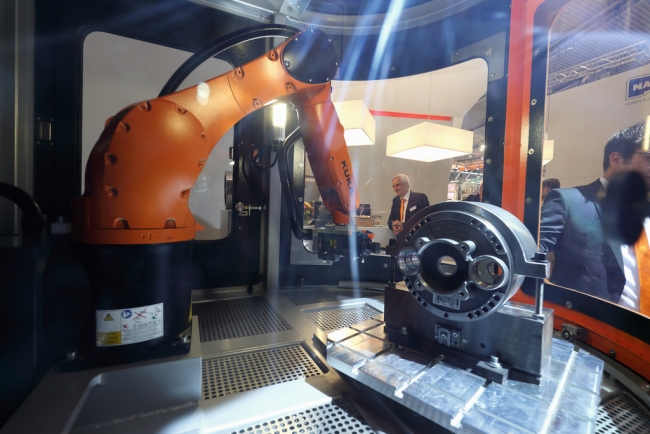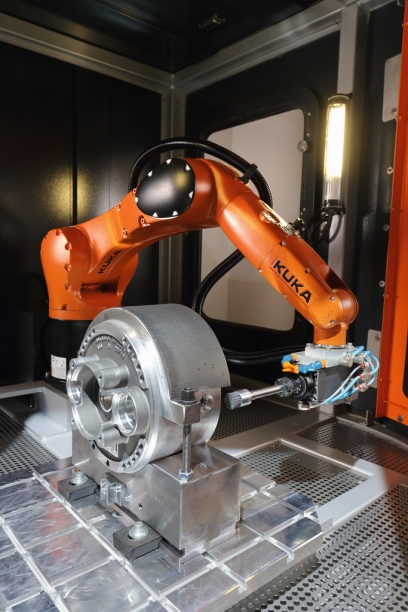4 minute read • published in partnership with KUKA
Insight: Can robots really replace traditional tools?
With demand steadily improving in key export markets, 63% of UK manufacturers are currently looking to upgrade or replace existing equipment. A recent survey by MAKE UK stated that the topmost reason cited by manufacturers for increasing investment was to expand into new areas of activity. Philippa Glover from KUKA Platinum System Partner CNC Robotics asks, can robots really replace traditional tools?
According to a survey by The Manufacturer, more than 70% believe that conditions are right for improving exports, however, only 30% of manufacturers in the MAKE UK survey were looking to technology as part of their capital expenditure. Those choosing to invest in technology realise the benefits that automation can bring, but overall they remain a small proportion of the total of UK manufacturers. In a competitive manufacturing market, any small advantage impacts the bottom line. So why when all the evidence supports automation is there still hesitancy in embedding new technology?
There is a perception that robotic machining tools lack accuracy over more traditional tools. Manufacturers worry that quality will deteriorate and ultimately hit profits, many SMEs worry about the increased set-up costs of introducing automated processes as well as installation costs associated with the introduction of digitalisation.

63% of UK manufacturers are currently looking to upgrade or replace existing equipment / Picture: KUKA UK
Many SMEs who make the shift to automation find that the quality actually increases with the change. Reliable from the start, a robotic system is more agile and flexible than even the latest CNC cutting lasers with the head of the robot being rotational and able to point in the direction it needs to go. Once installed the programme set up time is actually reduced, robotic systems can be programmed at a fraction of the time of traditional tools.
Traditional CNC machines are dependent upon the operator and therefore a variable production output is often seen with different users/shifts. Typically with automation, the production processes do not vary from one trained user to another. Research in America shows that manual machining tools are only functional for 65% of the available time, compared with manufacturers with automated systems who utilise their machines 85% of the time. That is set to increase, with more and more manufacturers running their robotic systems 24/7 with no downtime.
At CNC Robotics we work with KUKA robots, which are some of the most versatile and adaptable machines on the market, a large part of this versatility is in the range of available end effectors which can be paired with these nimble robots, each one optimised for a different use. We know that data on the accuracy of a machine is an important element in the decision-making process and its on-going use. In order to give clients reassurance, we have invested in a portable inspection arm designed to measure large objects without the need to move them to a dedicated inspection laboratory. This new capability allows us to check and confirm the accuracy of machining solutions prior to installation. The Romer Arm is part of Hexagon’s Manufacturing Intelligence which is designed to support the development of a world where quality drives productivity.

By demonstrating the robotic machining accuracy, CNC Robotics is able to build confidence in the growing robotic automation solutions market / Picture: KUKA UK
Michele Pollastri, Design Engineer at CNC Robotics said: “When used in conjunction with the program Power Inspection we can detect the shape of the object created, align it with and compare it to the CAD model. This provides us with real data on defects which can be used to further develop the programme to create a solution that meets the required specification.”
Through this investment, CNC Robotics can provide data on the accuracy of machining solutions for clients. By demonstrating the robotic machining accuracy, we are able to build confidence in the growing robotic automation solutions market.
Whilst machining speeds and feeds are specific to each client, there is no doubt that automation brings consistency, a controlled environment and an easier set up which impacts significantly upon productivity. Software advances have simplified, the programmes and processes for managing the systems are operator friendly and make production more successful. Couple this with more sophisticated spindles and robotic parts, this makes the investment to automation more compelling.
However, this is not a binary choice, there is a growing trend amongst manufacturers for a mix use workshop, with robotic systems complimenting traditional tooling machines. The cost of robot technology is falling, on average they are cheaper than some traditional tools. The return on investment for embedding automation can easily be justified, with significant evidence that costs are recouped due to increased efficiencies and the winning of larger contracts/repeat businesses due to new capacity and streamlined production. This cost-effective route is the answer to many manufacturers as they continue to find innovative ways to remain ahead of their competition and to be profitable in the global market.
